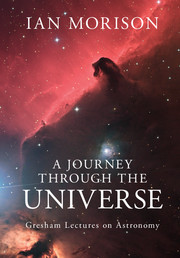Book contents
- Frontmatter
- Dedication
- Contents
- Preface
- Acknowledgements
- 1 Watchers of the skies
- 2 Our Sun
- 3 Aspects of our Solar System
- 4 The rocky planets
- 5 The hunt for Planet X
- 6 Voyages to the outer planets
- 7 Harbingers of doom
- 8 Impact!
- 9 Four hundred years of the telescope
- 10 The family of stars
- 11 Aging stars
- 12 The search for other worlds
- 13 Are we alone? The search for life beyond the Earth
- 14 Our island Universe
- 15 Wonders of the southern sky
- 16 Proving Einstein right
- 17 Black holes: no need to be afraid
- 18 It’s about time
- 19 Hubble’s heritage: the astronomer and the telescope that honours his name
- 20 The violent Universe
- 21 The invisible Universe: dark matter and dark energy
- 22 The afterglow of creation
- 23 To infinity and beyond: a view of the cosmos
- Index
- Plate section
- References
2 - Our Sun
Published online by Cambridge University Press: 05 October 2014
- Frontmatter
- Dedication
- Contents
- Preface
- Acknowledgements
- 1 Watchers of the skies
- 2 Our Sun
- 3 Aspects of our Solar System
- 4 The rocky planets
- 5 The hunt for Planet X
- 6 Voyages to the outer planets
- 7 Harbingers of doom
- 8 Impact!
- 9 Four hundred years of the telescope
- 10 The family of stars
- 11 Aging stars
- 12 The search for other worlds
- 13 Are we alone? The search for life beyond the Earth
- 14 Our island Universe
- 15 Wonders of the southern sky
- 16 Proving Einstein right
- 17 Black holes: no need to be afraid
- 18 It’s about time
- 19 Hubble’s heritage: the astronomer and the telescope that honours his name
- 20 The violent Universe
- 21 The invisible Universe: dark matter and dark energy
- 22 The afterglow of creation
- 23 To infinity and beyond: a view of the cosmos
- Index
- Plate section
- References
Summary
Any journey (and you must admit ours is a pretty epic journey) must start somewhere. Perhaps following the ideas of the Copernicus rather than Ptolemy, it seems that a logical place to start would be at the centre of the Sun. Here, the temperature is ~15 million degrees kelvin (K), which has no real meaning to us except that it is very hot indeed. This is simply telling us how fast the particles within the central core of the Sun are moving and this is the key to how the Sun creates its energy. The core largely comprises protons (the nuclei of hydrogen), alpha particles (the nuclei of helium, consisting of two protons and two neutrons) and electrons.
Up to the late 1800s, scientists could not understand how the Sun could create so much light and heat. Had the Sun been entirely made of something like coal (along with the oxygen it would need to burn) it would have burnt itself up in about a thousand years. Since the Sun had been providing heat and light for at least several thousand years, a chemical source for the Sun’s energy was clearly impossible. Around 1870, Hermann von Helmholtz realised that, if the Sun were contracting in size, energy, derived from potential energy, could be released. Knowing the mass and size of the Sun and how much energy the Sun is continuously creating and sending out into space, he calculated how much the Sun would have to reduce in size to provide its observed output, and deduced that the Sun would be able to sustain its energy output for around 20 million years. In the late 1800s people were quite happy to assume that the Solar System was less than 20 million years old, so his idea was almost universally accepted as the likely way that the Sun creates its energy.
- Type
- Chapter
- Information
- A Journey through the UniverseGresham Lectures on Astronomy, pp. 12 - 25Publisher: Cambridge University PressPrint publication year: 2014



